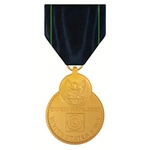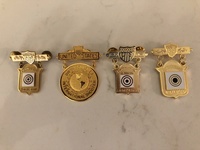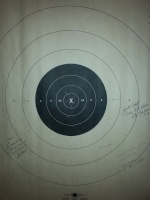Blank wall dry fire
+2
Chris Miceli
Magload
6 posters
Page 1 of 1
 Blank wall dry fire
Blank wall dry fire
Ok I thought I was getting some where with this dry firing at a blank wall. I had been using a small mark in the wall till everyone says use a blank wall. Using my MatchDot II I see no movement all the way through the shot. So to today a progressed to lesson 2 and well added lesson 3 in with it. I shot blank copy paper at 20yds indoor but loaded each mag with 2 dummy rounds a a live round. hey I got petty good at loading the mags with my eyes locked on the target. Petty good training for SD shooting. Well doing this I can see my wobble and the movement when the shot breaks. I shot 25 rounds of live ammo so ended up with 75 shots. This lesson was a big help as the last 15 live rounds was a 3 1/2" group. I am sure all the dummy rounds were Xs. Sure they were dream on. This all leads to the question should I be dry firing a a dot on the wall to see the movement or just work on proper trigger pulls. Don

Magload- Posts : 1173
Join date : 2016-11-18
Age : 77
Location : NE Florida
 Re: Blank wall dry fire
Re: Blank wall dry fire
A drill i started with when I was getting into bullseye is to take some brand new #2 pencils and sharpen them. Place them in your 45 barrel with the hammer cocked. Now dry fire on the wall or a piece of paper. You muzzle should only be 1-2 inches from the wall.
When your done dry firing you'll see a nice group of Pencil marks. Hopefully really tight group
When your done dry firing you'll see a nice group of Pencil marks. Hopefully really tight group
Last edited by Chris Miceli on Tue Jan 24, 2017 9:46 am; edited 1 time in total
Chris Miceli- Posts : 2715
Join date : 2015-10-27
Location : Northern Virginia
 Re: Blank wall dry fire
Re: Blank wall dry fire
Chris I have done that in the Navy when they wouldn't give us range time. You don't hear that method much anymore. DonChris Miceli wrote:A drill i started with I was getting into bullseye is to take some brand new #2 pencils and sharpen them. Place them in your 45 barrel with the hammer cocked. Now dry fire on the wall or a piece of paper. You muzzle should only be 1-2 inches from the wall.
When your done dry firing you'll see a nice group of Pencil marks. Hopefully really tight group

Magload- Posts : 1173
Join date : 2016-11-18
Age : 77
Location : NE Florida
 Re: Blank wall dry fire
Re: Blank wall dry fire
IMO, the dry fire at a blank wall works best with iron sights. What you're after here is the trigger release disturbing the alignment of the sights. With a blank wall you're not looking for wobble area reduction it is to develop good trigger release. So if you can confirm a consistently good release with a few sessions of blank wall and iron sights, then dry fire should be used to reduce wobble area and for that you neeed An aiming reference. While a round black dot can be used, other references can be used like a small cross oriented vertically and horizontally.
If you do the pencil dot method wrap tape around the pencil to make it slide in the center of the bore.
If you do the pencil dot method wrap tape around the pencil to make it slide in the center of the bore.

Wobbley- Admin
- Posts : 4776
Join date : 2015-02-13
 Re: Blank wall dry fire
Re: Blank wall dry fire
Yes, you should be dryfiring, even with a dot, on a blank wall.
Doing this with open sights is generally more productive, since you can see the movement of the gun from the relationship of the front and rear sights. That helps see what is "wobble" of the whole gun, hand, arm, etc. system versus what is happening to change the angular position of the gun from its parallel alignment with the intended line of sight (relation of front and rear sight).
When dryfiring with a dot, it it generally more productive to stand on the other side of room or at least not right up against the wall. That gives you a better perspective on the wobble and the dot position. For dots, use the dryfiring to keep the dot exactly centered in tube, all the way through the trigger press and after. (What sometimes happens is the shooter is keeping the dot on the same area or close to it, but the gun is twisting or moving and the shooter is compensating with the hand, wrist or fingers to keep the dot in position on the wall, but the dot is not centered in the tube.) With this exercise, we are looking (pun intended) for no drifting or movement of the dot within the tube, not just looking for wobble on the wall.
Hope this helps.
CR
Doing this with open sights is generally more productive, since you can see the movement of the gun from the relationship of the front and rear sights. That helps see what is "wobble" of the whole gun, hand, arm, etc. system versus what is happening to change the angular position of the gun from its parallel alignment with the intended line of sight (relation of front and rear sight).
When dryfiring with a dot, it it generally more productive to stand on the other side of room or at least not right up against the wall. That gives you a better perspective on the wobble and the dot position. For dots, use the dryfiring to keep the dot exactly centered in tube, all the way through the trigger press and after. (What sometimes happens is the shooter is keeping the dot on the same area or close to it, but the gun is twisting or moving and the shooter is compensating with the hand, wrist or fingers to keep the dot in position on the wall, but the dot is not centered in the tube.) With this exercise, we are looking (pun intended) for no drifting or movement of the dot within the tube, not just looking for wobble on the wall.
Hope this helps.
CR
CR10X- Posts : 1777
Join date : 2011-06-17
Location : NC
 Re: Blank wall dry fire
Re: Blank wall dry fire
+1 dot in center of tube, not the only HM to say this.CR10X wrote:Yes, you should be dryfiring, even with a dot, on a blank wall.
Doing this with open sights is generally more productive, since you can see the movement of the gun from the relationship of the front and rear sights. That helps see what is "wobble" of the whole gun, hand, arm, etc. system versus what is happening to change the angular position of the gun from its parallel alignment with the intended line of sight (relation of front and rear sight).
When dryfiring with a dot, it it generally more productive to stand on the other side of room or at least not right up against the wall. That gives you a better perspective on the wobble and the dot position. For dots, use the dryfiring to keep the dot exactly centered in tube, all the way through the trigger press and after. (What sometimes happens is the shooter is keeping the dot on the same area or close to it, but the gun is twisting or moving and the shooter is compensating with the hand, wrist or fingers to keep the dot in position on the wall, but the dot is not centered in the tube.) With this exercise, we are looking (pun intended) for no drifting or movement of the dot within the tube, not just looking for wobble on the wall.
Hope this helps.
CR
Chris Miceli- Posts : 2715
Join date : 2015-10-27
Location : Northern Virginia
 Re: Blank wall dry fire
Re: Blank wall dry fire
Thanks all. Yes my lesson guide says to keep the dot centered in the tube and I am watching for that but guess I am not moving the gun in my grip when pulling the trigger as I am seeing no movement there. The movement I am seeing must be my arm movement as it is there when the shot breaks when holding the dot on a mark on the wall. I feel my trigger fundamentals are petty good as I shoot benchrest rifle and can shoot 1/3" groups at 100yds. I also shoot a lot of bench rest pistol as it it less hassle then using my Ransom Rest. I would contribute this movement to flinch but I shoot the 45 better then my 3 rimfires. The blank targets and 2 dummies and a live really helped yesterday. I maybe old but I think I still have time to make master at least. Don

Magload- Posts : 1173
Join date : 2016-11-18
Age : 77
Location : NE Florida
 Re: Blank wall dry fire
Re: Blank wall dry fire
A big misconception that shooters have about dryfiring on a blank wall is that we should not be looking to see how still we are holding the gun, but what is happening to the movement of gun (as provided by the feedback from the sights or dot). And this is without having a point of reference to rely on to start or complete the trigger pull.
Shooters that want to have a target point, dot, etc. are generally trying to stop the gun at a certain point and then trying to operate the trigger. Dryfiring is getting the trigger operating to trip the sear and the minimum wobble to coincide, without the trigger process affecting the minimum wobble.
A lot of shooters fall into the trap of having a point to look and and then trying to operate (read press harder, slower, snatch, jerk, spasm, move other fingers or grip, etc.) to try to get the shot off while the sights / dot are exactly still or on some particular point.
Dryfiring on a blank wall or target is used to get the shooter to see the wobble and how the shot process is influencing it. The trigger process should be continuous from the time the gun gets into the aiming area.
Additionally, you can train on holding to observe the wobble on a blank target, but if you use a target, you should be completing the trigger (dryfiring or live firing as well). Please don't train on just holding on a target, that's not what we want to do when actually shooting.
Shooters that want to have a target point, dot, etc. are generally trying to stop the gun at a certain point and then trying to operate the trigger. Dryfiring is getting the trigger operating to trip the sear and the minimum wobble to coincide, without the trigger process affecting the minimum wobble.
A lot of shooters fall into the trap of having a point to look and and then trying to operate (read press harder, slower, snatch, jerk, spasm, move other fingers or grip, etc.) to try to get the shot off while the sights / dot are exactly still or on some particular point.
Dryfiring on a blank wall or target is used to get the shooter to see the wobble and how the shot process is influencing it. The trigger process should be continuous from the time the gun gets into the aiming area.
Additionally, you can train on holding to observe the wobble on a blank target, but if you use a target, you should be completing the trigger (dryfiring or live firing as well). Please don't train on just holding on a target, that's not what we want to do when actually shooting.
CR10X- Posts : 1777
Join date : 2011-06-17
Location : NC
 Re: Blank wall dry fire
Re: Blank wall dry fire
CR10X wrote:A big misconception that shooters have about dryfiring on a blank wall is that we should not be looking to see how still we are holding the gun, but what is happening to the movement of gun (as provided by the feedback from the sights or dot). And this is without having a point of reference to rely on to start or complete the trigger pull.
Shooters that want to have a target point, dot, etc. are generally trying to stop the gun at a certain point and then trying to operate the trigger. Dryfiring is getting the trigger operating to trip the sear and the minimum wobble to coincide, without the trigger process affecting the minimum wobble.
A lot of shooters fall into the trap of having a point to look and and then trying to operate (read press harder, slower, snatch, jerk, spasm, move other fingers or grip, etc.) to try to get the shot off while the sights / dot are exactly still or on some particular point.
Dryfiring on a blank wall or target is used to get the shooter to see the wobble and how the shot process is influencing it. The trigger process should be continuous from the time the gun gets into the aiming area.
Additionally, you can train on holding to observe the wobble on a blank target, but if you use a target, you should be completing the trigger (dryfiring or live firing as well). Please don't train on just holding on a target, that's not what we want to do when actually shooting.
Yup. Read this, and then re-read it.
Pistol shooting is all about aggressively squeezing the trigger smoothly through your arc of movement, in order to get the shot to break within that arc. It sounds completely counter-intuitive, but it's what works.
Erich Buljung used to have us shoot into the backstop - no target at all. This trains you to focus completely on the shot process. The shooter that used this training technique to greatest effect was Mike Douglass, and he made the Olympic Team by doing so.
The target downrange has literally nothing to do with your ability to consistently put shots in a very small group.

john bickar- Posts : 2269
Join date : 2011-07-09
Age : 100
Location : Menlo Park, CA
 Re: Blank wall dry fire
Re: Blank wall dry fire
Yep! Squeeze the dang trigger ;l)
+ 1
Jon
+ 1
Jon

Jon Eulette- Posts : 4399
Join date : 2013-04-15
Location : Southern Kalifornia
 Similar topics
Similar topics» Dry firing at a blank wall
» Blank wall dryfire question
» Running into a wall during live fire
» Help with a dry fire technique for Rapid Fire Training
» Slow fire at timed fire pace?
» Blank wall dryfire question
» Running into a wall during live fire
» Help with a dry fire technique for Rapid Fire Training
» Slow fire at timed fire pace?
Page 1 of 1
Permissions in this forum:
You cannot reply to topics in this forum|
|
|
